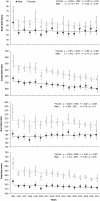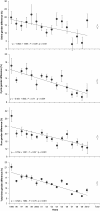The age of peak performance in Ironman triathlon: a cross-sectional and longitudinal data analysis
- PMID: 24004814
- PMCID: PMC3766705
- DOI: 10.1186/2046-7648-2-27
The age of peak performance in Ironman triathlon: a cross-sectional and longitudinal data analysis
Abstract
Background: The aims of the present study were, firstly, to investigate in a cross-sectional analysis the age of peak Ironman performance within one calendar year in all qualifiers for Ironman Hawaii and Ironman Hawaii; secondly, to determine in a longitudinal analysis on a qualifier for Ironman Hawaii whether the age of peak Ironman performance and Ironman performance itself change across years; and thirdly, to determine the gender difference in performance.
Methods: In a cross-sectional analysis, the age of the top ten finishers for all qualifier races for Ironman Hawaii and Ironman Hawaii was determined in 2010. For a longitudinal analysis, the age and the performance of the annual top ten female and male finishers in a qualifier for Ironman Hawaii was determined in Ironman Switzerland between 1995 and 2010.
Results: In 19 of the 20 analyzed triathlons held in 2010, there was no difference in the age of peak Ironman performance between women and men (p > 0.05). The only difference in the age of peak Ironman performance between genders was in 'Ironman Canada' where men were older than women (p = 0.023). For all 20 races, the age of peak Ironman performance was 32.2 ± 1.5 years for men and 33.0 ± 1.6 years for women (p > 0.05). In Ironman Switzerland, there was no difference in the age of peak Ironman performance between genders for top ten women and men from 1995 to 2010 (F = 0.06, p = 0.8). The mean age of top ten women and men was 31.4 ± 1.7 and 31.5 ± 1.7 years (Cohen's d = 0.06), respectively. The gender difference in performance in the three disciplines and for overall race time decreased significantly across years. Men and women improved overall race times by approximately 1.2 and 4.2 min/year, respectively.
Conclusions: Women and men peak at a similar age of 32-33 years in an Ironman triathlon with no gender difference. In a qualifier for Ironman Hawaii, the age of peak Ironman performance remained unchanged across years. In contrast, gender differences in performance in Ironman Switzerland decreased during the studied period, suggesting that elite female Ironman triathletes might still narrow the gender gap in the future.
Figures





Similar articles
-
Age of peak performance in elite male and female Ironman triathletes competing in Ironman Switzerland, a qualifier for the Ironman world championship, Ironman Hawaii, from 1995 to 2011.Open Access J Sports Med. 2012 Nov 2;3:175-82. doi: 10.2147/OAJSM.S37115. eCollection 2012. Open Access J Sports Med. 2012. PMID: 24198600 Free PMC article.
-
A comparison of participation and performance in age-group finishers competing in and qualifying for Ironman Hawaii.Int J Gen Med. 2013;6:67-77. doi: 10.2147/IJGM.S40202. Epub 2013 Feb 22. Int J Gen Med. 2013. PMID: 23459419 Free PMC article.
-
The best triathletes are older in longer race distances - a comparison between Olympic, Half-Ironman and Ironman distance triathlon.Springerplus. 2014 Sep 18;3:538. doi: 10.1186/2193-1801-3-538. eCollection 2014. Springerplus. 2014. PMID: 25279329 Free PMC article.
-
Trends in Triathlon Performance: Effects of Sex and Age.Sports Med. 2013 Sep;43(9):851-63. doi: 10.1007/s40279-013-0067-4. Sports Med. 2013. PMID: 23797729 Review.
-
What predicts performance in ultra-triathlon races? - a comparison between Ironman distance triathlon and ultra-triathlon.Open Access J Sports Med. 2015 May 18;6:149-59. doi: 10.2147/OAJSM.S79273. eCollection 2015. Open Access J Sports Med. 2015. PMID: 26056498 Free PMC article. Review.
Cited by
-
What is the age for the fastest ultra-marathon performance in time-limited races from 6 h to 10 days?Age (Dordr). 2014;36(5):9715. doi: 10.1007/s11357-014-9715-3. Epub 2014 Oct 4. Age (Dordr). 2014. PMID: 25280550 Free PMC article.
-
The influence of origin and race location on performance in IRONMAN® age group triathletes.PLoS One. 2024 Dec 9;19(12):e0315064. doi: 10.1371/journal.pone.0315064. eCollection 2024. PLoS One. 2024. PMID: 39652572 Free PMC article.
-
Women in the triathlon-the differences between female and male triathletes: a narrative review.Front Sports Act Living. 2025 Jun 6;7:1567676. doi: 10.3389/fspor.2025.1567676. eCollection 2025. Front Sports Act Living. 2025. PMID: 40546782 Free PMC article. Review.
-
The fastest nonprofessional age group IRONMAN triathletes in the world originate from Europe.Sci Rep. 2025 Jan 6;15(1):1028. doi: 10.1038/s41598-024-84008-9. Sci Rep. 2025. PMID: 39762336 Free PMC article.
-
Changes in pacing variation with increasing race duration in ultra-triathlon races.Sci Rep. 2023 Mar 6;13(1):3692. doi: 10.1038/s41598-023-30932-1. Sci Rep. 2023. PMID: 36878948 Free PMC article.
References
-
- Berthelot G, Len S, Hellard P, Tafflet M, Guillaume M, Vollmer JC, Gager B, Quinquis L, Marc A, Toussaint JF. Exponential growth combined with exponential decline explains lifetime performance evolution in individual and human species. Age (Dordr) 2012;34:1001–1009. doi: 10.1007/s11357-011-9274-9. - DOI - PMC - PubMed
-
- Hunter SK, Stevens AA, Magennis K, Skelton KW, Fauth M. Is there a sex difference in the age of marathon runners? Med Sci Sports Exerc. 2011;43:656–664. - PubMed
LinkOut - more resources
Full Text Sources
Other Literature Sources
Miscellaneous

